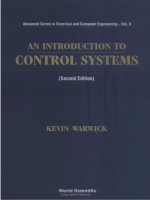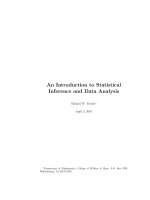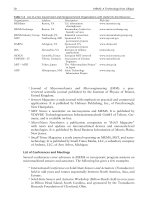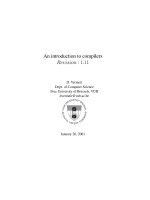an introduction to functional analysis - vitali milman
Bạn đang xem bản rút gọn của tài liệu. Xem và tải ngay bản đầy đủ của tài liệu tại đây (704.38 KB, 143 trang )
Vitali Milman
An Introduction To
Functional Analysis
WORLD 1999
2
3
dedications
4
Contents
1 Linear spaces; normed spaces; first examples 9
1.1 Linear spaces . . . . . . . . . . . . . . . . . . . . . . . 9
1.2 Normed spaces; first examples . . . . . . . . . . . . . 11
1.2.1 H¨older inequality. . . . . . . . . . . . . . . . . 12
1.2.2 Minkowski inequality . . . . . . . . . . . . . . 13
1.3 Completeness; completion . . . . . . . . . . . . . . . 16
1.3.1 Construction of completion . . . . . . . . . . 17
1.4 Exercises . . . . . . . . . . . . . . . . . . . . . . . . . 18
2 Hilbert spaces 21
2.1 Basic notions; first examples . . . . . . . . . . . . . . 21
2.1.1 Cauchy-Schwartz inequa lity . . . . . . . . . . 22
2.1.2 Bessel’s inequality . . . . . . . . . . . . . . . 23
2.1.3 Gram-Schmidt orthogonalization procedure . 24
2.1.4 Parseval’s equality . . . . . . . . . . . . . . . 25
2.2 Projections; decompositions . . . . . . . . . . . . . . 27
2.2.1 Separable case . . . . . . . . . . . . . . . . . . 27
2.2.2 Uniqueness of the distance from a point t o a
convex set: the geometric meaning . . . . . . 27
2.2.3 Orthogonal decomposition . . . . . . . . . . . 28
2.3 Linear functionals . . . . . . . . . . . . . . . . . . . . 29
2.3.1 Linear functionals in a general linear space . 29
2.3.2 Bounded linear functionals in normed spaces.
The norm of a functional . . . . . . . . . . . . 31
2.3.3 Bounded linear functionals in a Hilbert space 32
2.3.4 An Example of a no n-separable Hilbert space: 32
2.4 Exercises . . . . . . . . . . . . . . . . . . . . . . . . . 33
5
6
CONTENTS
3 The dual space 39
3.1 Hahn-Banach theorem and its first consequences . 39
3.2 Dual Spaces . . . . . . . . . . . . . . . . . . . . . . . 41
3.3 Exercises: . . . . . . . . . . . . . . . . . . . . . . . . . 42
4 Bounded linear operators 43
4.1 Completeness of the space of bounded linear opera-
tors . . . . . . . . . . . . . . . . . . . . . . . . . . . . 43
4.2 Examples of linear operators . . . . . . . . . . . . . . 44
4.3 Compact operators . . . . . . . . . . . . . . . . . . . 45
4.3.1 Compact sets . . . . . . . . . . . . . . . . . . 46
4.3.2 The space of compact operators . . . . . . . . 48
4.4 Dual Operators . . . . . . . . . . . . . . . . . . . . . . 48
4.5 Different convergences in the space
of bounded operators . . . . . . . . . . . . . . . 50
4.6 Invertible Operators . . . . . . . . . . . . . . . . . . 52
4.7 Exercises . . . . . . . . . . . . . . . . . . . . . . . . . 52
5 Spectral theory 57
5.1 Classification of spectrum . . . . . . . . . . . . . . . 57
5.2 Fredholm Theory of compact operators . . . . . . . . 58
5.3 Exercises . . . . . . . . . . . . . . . . . . . . . . . . . 63
6 Self adjoint compact operators 65
6.1 General Properties . . . . . . . . . . . . . . . . . . . 65
6.2 Exercises . . . . . . . . . . . . . . . . . . . . . . . . . 72
7 Self- adjoint bounded operat ors 73
7.1 Order in the space of symmetric operators . . . . . . 73
7.1.1 Properties . . . . . . . . . . . . . . . . . . . . 73
7.2 Projections (projection operators) . . . . . . . . . . . 77
7.2.1 Some properties of projections in linear
spaces . . . . . . . . . . . . . . . . . . . . . . 77
8 Functi ons of operators 79
8.1 Properties of this correspondence ( ) . . . . . . 80
8.2 The main inequality . . . . . . . . . . . . . . . . . . . 82
8.3 Simple spectrum . . . . . . . . . . . . . . . . . . . . . 85
9 Spectral theory of unitary operators 87
9.1 Spectral properties . . . . . . . . . . . . . . . . . . . 87
CONTENTS
7
10 The Fundamental Theorems. 91
10.1 The open mapping theorem . . . . . . . . . . . . . . 92
10.2 The Closed Graph Theorem . . . . . . . . . . . . . . 94
10.3 The Banach-Steinhaus Theorem . . . . . . . . . . . 95
10.4 Bases In Banach Spaces . . . . . . . . . . . . . . . . 99
10.5 Hahn-Banach Theorem.
Linear functionals . . . . . . . . . . . . . . . . . . . . 100
10.6 Extremal points; The Krein-Milman Theorem . . . . 108
11 Banach algebras 111
11.1 Analytic fu nctions . . . . . . . . . . . . . . . . . . . . 114
11.2 Radicals . . . . . . . . . . . . . . . . . . . . . . . . . . 118
11.3 Involutions . . . . . . . . . . . . . . . . . . . . . . . . 120
12 Unbounded self-adjoint and symmetric operators in 127
12.1 More Properties Of Operators . . . . . . . . . . . . . 131
12.2 The Spectrum . . . . . . . . . . . . . . . . . . . 132
12.3 Elements Of The “Graph Method” . . . . . . . . . . . 133
12.4 Reduction Of Operator . . . . . . . . . . . . . . . . . 134
12.5 Cayley Transform . . . . . . . . . . . . . . . . . . . . 136
8
CONTENTS
Chapter 1
Linear spaces; norm e d
spaces; first examples
1.1 Linear spaces
I
N THIS course we study linear spaces over the field of real
or complex nu mbers or . The simplest examples of linear
spaces st udied in a course of Linear Algebra are those of the
–dimensional vector spaces , or the space of polynomials of
degree, say, less than .
An important example of linear space is the space of con-
tinuous real (or complex) valued functions on the int erval .
A map between two linear spaces and is called
linear if and only if for every and for every scalar we
have that
(1.1)
For such maps we usually write instead of . Moreover, we
define two important sets associated with a linear map , its kernel
and its image defined by:
(1.2)
and
(1.3)
A linear map between two linear spaces and is
called isomorphism if and , that is is an one to
9
10
CHAPTER 1. LINEAR SPACES; NORMED SPACES; FIRST EXAMPLES
one and onto linear map and consequently it is invertible. We write
for its inverse.
Examples of linear spaces.
1. is the set of finite support sequences; that is, the se-
quences with all but finite zero elements. It is a linear space with
respect to addition of sequences and obviously isomorphic to the
space of all polynomials.
2. The set of sequences tending to zero.
3. The set of all convergent sequences.
4. The set of all bounded sequences.
5. The set of all sequences.
All of these form linear spaces and they relate in the following
way:
(1.4)
Definition 1.1.1 A linear space is called a subspace of the linear
space if and only if and the linear structure of restricted
on gives the linear structure of . We will write .
A set of vectors is called linearly dependent set and
the vectors linearly dependent vectors, if there exist nu mbers
not all of them zero, so that
(1.5)
On the other hand are called linearly independent if they are
not linearly dependent.
We define t he linear span of a subset of a linear space to be
the intersection of all subspaces of containing . That is,
(1.6)
An important theorem of linear algebra states:
Theorem 1.1.2 Let be a maximal set of linearly independent
vectors in (meaning t hat there is no linear independent extension of
this set). Then the number is invariant and it is called the dimension
of the space . We write dim and we say that the vectors
form a basis of .
1.2. NORMED SPACES; FIRST EXAMPL ES
11
Next we introduce the notion of quotient spaces. For a subspace
of we define a new linear space called the quotient space of
with respect to in the following way. First we consider the
collection of subsets
(1.7)
The sets are called cosets of . Note that two cosets and
are either identical or they are disjoint sets. Indeed, if
then are both elements of . Since is a linear space it
follows that . Thus, if we have
and again by the linear structure of ,
that is, . So, we showed that . Similarly one shows
that .
Now we introduce a linear structure on by
Note that is a zero of the new space . The dimension dim
is called the codimension of and we write or
simply if it is obvious to which space it refers to.
Example: The codimension of inside the space of convergent
sequences is equal to 1. Indeed, for every ,
where .
Lemma 1.1.3 If then there exist such that
for every there are numbers and such that
(1.8)
Proof: Let be a basis of . Then the vectors
are linearly independent and moreover if The reader should
now try the
exercises 1,2
then for all [Indeed, hence and
now it follows from the linear independence of the ’s]. Now
, consider that is .
1.2 Normed spaces; first examples
We now proceed to define the notion of “distance” in a linear space.
This is necessary if one wants to do analysis and st udy convergence.
12
CHAPTER 1. LINEAR SPACES; NORMED SPACES; FIRST EXAMPLES
Definition 1.2.1 A norm for is a function from to
satisfying the following properties:
1. and if and only if .
2. .
3. (triangle inequality)
for all and for all (or if the space is over t he field )
With this definition the distance between two points and in
is the norm of the difference: .
Examples. On the spaces we define the norm to be the
supremum of the absolute value of the sequences: for
we set (exercise: check that this supremum defines a
norm).
For the space we define the norm of a function to be the
. An other example is the space
which consists of all the sequences satisfying
(1.9)
Similarly we define the spaces for by
requiring that
(1.10)
It is already not trivial that these sets (for ) form linear
spaces. In fact, we first prove that the function is indeed a
norm and the triangle inequality implies that if and are in
then is also in . This follows from the following inequality of
H¨older.
1.2.1 H
¨
older i nequality.
Theorem 1.2.2 For every sequence of scalars and we have:
(1.11)
where .
1.2. NORMED SPACES; FIRST EXAMPL ES
13
Let us first observe a few connections between the numbers
and :
(1.12)
In or der to pro ve the above inequality we set and
. Then and . Now check that
. Indeed, this is true because one considers the
function and integrate this with respect to from zero to
; and integrate with respect to its inverse from
zero to . It is easy to see geometrically, that the sum of these two
integrals always exceeds the product and it equals .
Adding up we get
(1.13)
The above inequality is called the Cauchy inequality if
. From the inequality of H¨older follows the Minkowski inequality
which is the triangle inequality for the spaces .
1.2.2 Minkowski inequality
Theorem 1.2.3 For every sequence of scalars and
and for we have:
(1.14)
Proof:
for such that .
14
CHAPTER 1. LINEAR SPACES; NORMED SPACES; FIRST EXAMPLES
A few topological remarks are due. We say that a sequence
converges to a point in the space if and only if . An
open ball of radius centered at is defined to be the set
(1.15)
and a set is said t o be open if and only if for every there
exists such that . A set is said to be closed if for
every sequence that converges to some it follows that
.
Lemma 1.2.4 If is an open set then the set is closed.
Conversely, if is a closed set then the set is open.
Proof: Let and . If then for any
and large enough, which implies that for large
enough, and not in . For the converse now, for every
there exists such that . If not for every decreasing to
zero sequence of ther e exist and which
implies that that is .
We a lso note here that the union of open sets is open and the
intersection of closed sets is closed.
We start now discussing some geometric ideas. If two points
and are given then the set for is the line
segment joining these two points. We also call this set an interval
and we write .
Exercise. Check that if then
that is, the triangle inequality becomes equality.
Definition 1.2.5 A subset of a linear space is called convex if
and only if for every two points the interval is con-
tained in .
It is easy to see (an exercise) that if is a family of convex
sets then the intersection is also a convex set. We observe
here that for being a linear nor med space the set
(1.16)
called the u nit ball of t he space , is a convex (check!) and sym-
metric with respect to the origin (centrally symmetric) set.
1.2. NORMED SPACES; FIRST EXAMPL ES
15
Lemma 1.2.6 If , and is closed subspace then is a
normed space and for its norm is given by
(1.17)
Proof: If then there exists a sequence such that
for some ( is closed) hence . Homogeneity
is easy since is a linear space and finally we prove the triangle
inequality. Since , for every we
take so that
(1.18)
and
(1.19)
So, for every we have that
finishing the pro o f.
A weaker notion than that of the norm is the notion of the semi-
norm.
is a seminorm on a linear space if it satisfies the properties
of the norm except that it may be zero for non-zero vectors. So, a
seminorm satisfies
1.
2.
3.
for all and all (or ).
It is useful to note here that if is a seminorm and we set to
be its kernel, that is, , then
1. is a subspace
and
2. can define a norm on the quotient
Indeed the first is true from the triangle inequality and the second
is true since is independent of :
and similarly
.
16
CHAPTER 1. LINEAR SPACES; NORMED SPACES; FIRST EXAMPLES
An analogue of the spaces is provided by the spaces of func-
tions with finite –norm: We define the space of continuou s func-
tions so that if then
We note here that the quantity is a seminorm and hence we
have to pass to a quotient space if we want to get a norm. Thus
we pass to quotient as described above (quotient with respect to
the set of zeroes of ). In this space now we see the following
“problem”. It is easily seen that there exist sequences of continuousThe reader should
now try the
exercises 3 to 19
functions and non continuous function so that the quant ity
converges to zero. So is inside the space but converges
to a function “outside” the space of continuous functions. These
spaces are called “incomplete”. In the next section we look into the
complete spaces.
1.3 Completeness; comp letion
To approach the general picture we need the following definition.
Definition 1.3.1 A normed space is called complete if and only
if every Cauchy sequence in converges to an element of the
space .
Examples.
1. It is well known from the standard calculus courses that if
is a Cauchy sequence in the space equipped with
the supremum norm (i.e., for every there is
such that for all bigger than
and for a ll then there exists a continuous function
such that
as goes to infinity. Thus the space equipped with the
norm is a complete normed space.
1.3. COMPLETENESS; COMPLETION
17
2. The space is a complete normed space, since if
is a Cauchy sequence with the norm then each sequence
is a Cauchy sequence and by the completeness of or
there exists the limit of as tends to infinity. Let
Then
for some . Thus Finally for big
so passing to the limit as goes to infinity we get that
, consequently .
Note, that the same proof (with the obvious modifications) works
for the spaces as well.
3. The space of sequences converging to zero, equipped with
the supremum norm is complete (left as an exercise).
For non complete normed spaces there exists a procedure to “fill
in the gaps” and make them complete.
Theorem 1.3.2 Let be a normed linear space. There exists a com- The reader should
now try the exercise
20
plete normed space and a linear operator such that (i)
(isometry into); (ii) ( ) is a dense set in (i.e.
).
[Also, in the sense which we don’t explain now, such a is unique.Expla in
this]
1.3.1 Construction of complet ion
Let be the (linear) space of all Cauchy sequences
(1.20)
in . Introduce a seminorm in the space : ,
where is a Cauchy sequence. Note that the limit always
exists. [Indeed, as , by the
definition of Cauchy sequences; so is a Cauchy sequence of
numbers and therefore converges.]
18
CHAPTER 1. LINEAR SPACES; NORMED SPACES; FIRST EXAMPLES
Define , so that is the subspace of all
sequences which converge to . Then defines a norm on the
quotient space (as explained earlier) by the same for-
mula (for any representative of an equiva-
lent class . The operator is de-
fined by ( ) where is the constant sequence
). (A constant sequence is, of course, a Cauchy
sequence and .)
Now, to prove the theorem, we should prove (a) is dense in
; and (b) is a complete space.
Proof: (a) Forall and , there exists such that
for . Define ,
a constant sequence; i.e. . Then the distance the distance
from to is . Thus, every is approximable by
elements of .
(b) Let as (i.e. is a Cauchy
sequence in and represents a Cauchy sequence in ). Take
and such that . Then is a
Cauchy sequence in . Indeed,
as . Then
is a Cauchy sequence (so it belongs to ) and .
Indeed, .
(Compare this with the construction of irrational numbers from
rational ones.)
The completion of is called . Hence, an element
in is a class of functions, but we will always choose a rep-
resentative of this class and will treat it as an element of the space
. The most important space for us is .
1.4 Exercises
1. Consider the linear space of double sequences
such that the limits and exist. Con-
sider moreover the subspace of the sequences
such that . Find the dimension and a basis of
the space .
2. Consider the linear space of all sequences such
that converges for . Find the dimension
1.4. EXERCISES
19
and a basis for the space .
3. Let be an open set. Prove that the set is closed.
4. Let be a closed set. Prove that the set is open.
5. Let be a normed linear space and be a closed sub-
space. Then is a normed linear space with t he norm
6. Prove that
(a) the union of any family of open sets is open set.
(b) the intersection of any family of closed sets is a closed set.
7. Prove that a ball is a convex set.
8. Show that there exists t w o vectors and in the space
such that they are linearly independent, and
.
9. Prove that if the unit sphere of a normed linear space contains
a line segment, then there exist vectors and such that
and are linearly independent (a line segment
is a set of the form ).
10. Prove that if a normed linear space contains linearly inde-
pendent vectors and such that ,
, then there exists a line segment cont ained in the
unit sphere of .
11. Given the two spheres and
in a normed linear space, how many points can these
spheres have in common?
12. Find the intersection of the unit ball in with the following
subspaces:
(a) span
(b) span
(c) span .
13. Compute the norm of a vector in the factor space (see
exercise 1).
20
CHAPTER 1. LINEAR SPACES; NORMED SPACES; FIRST EXAMPLES
14. Prove that if then
15. Prove that if then for every finite
segment
16. Prove that for no space is a subspace of
17. Let be numbers such that and Let
Prove that
and
18. Let For which the function
belongs to
19. (a) Prove that the intersection of the two balls
and in a normed lenear
space is empty iff
(b) I s the intersection of the two balls and in the space
empty if and
?
20. Let in the supremum norm. Prove
that .
Chapter 2
Hilbert spaces
2.1 Basic notions; first examples
Let be a linear space over with a given complex value function of
two variables , which has the following properties:
1. linearity with respect to the first argument:
(2.1)
2. complex conjugation: ; this implies “semi-linearity”
with respect the second argument:
.
3. non-negativeness: , and ifand only if .
Such a function is called “inner product”. Consider also t he
function . (We will see later that is a norm and
will write .)
Examples:
1. In let where , .
2. In let (by H¨older inequality
). So, .
3. In (re-write this par enthe-
sis using integrals, think about functions you know how to
21
22
CHAPTER 2. HILBERT SPACES
integrate; say, think about the Riemannian integral) let
. A gain, by the “Cauchy-Schwartz”
inequality, that is, H¨older inequality for .
2.1.1 Cauchy-Schwartz inequality
Theorem 2.1.1 (Cauchy-Schwartz inequality) For all vectors
in a linear sp ace with inner product , the following inequality is
true:
(2.2)
Proof: Recall our notation . Then
.
If take which implies
the Cauchy-Schwartz inequality. Moreover if and
only if .
Exercise: Let satisfy all three conditions of the inner product
except that may be zero for non-zero elements. Prove that the
Cauchy-Schwartz inequa lity is still true.
Now we w ill prove that is a no rm. Indeed:
and the triangle inequality holds:
and because of the Cauchy-Schwartz inequality:
. We see that and we will use instead
of .
So, is a normed space with a norm defined by the inner
product in . We call a Hilbert space if is a complete normed
space with this norm.
Moreover a general complete normed space is called a Banach
space.
Exercises:
1. Check that the inner product is a continuous function
with respect to both variables: when
2.1. BASIC NOTIONS; FIRST EXAMPLES
23
and . [Consider the expression
and use the Cauchy-Schwartz inequality.]
2. Parallelogram Law:
3. Define the notion o f orthogonality: if and only if .
4. Pythagorean Theorem: if then (Proof:
.)
Corollary 2.1.2 If are pairwise orthogonal and normalized in
(i.e. ) then ; moreover,
(under the condition ). The c ompleteness of the Hilbert
space gives that if then the series converges. The reader should
now try the
exercises from 1 to
8
Indeed as .
2.1.2 Bessel’s inequal i ty
Theorem 2.1.3 (Bessel’s inequality) For any orthonormal system
, and for every we have: .
Proof: Consider . Then and
. Hence and
the series converges.
Corollary 2.1.4 For any and any orthonormal system ,
there exists . [Indeed, the in the previous proof
converge to as ].
Examples of orthonormal systems:
1. In consider t he vectors where the
appears in the -th position.
24
CHAPTER 2. HILBERT SPACES
2. In consider the vectors ;
3. In consider the vectors , for
We call a system a complete system in (or any other
normed space ) if the linear span
is a dense set in (or, correspondingly, in ).
Remarks. A few known theorems of Calculus state that some
systems of functions are complete in some spaces. The Weierstrass
approximation theorem, for example, states that the system
is complete in (meaning that polynomials are dense in ).
Since is dense in (by the definition of ) and the
convergence in implies in (check it!), it
follows that is a complete system in too.
Another version of the Weierstrass theorem states that the trigono-
metric polynomials are dense in the space of the continuous -
periodic functions on (in the -norm). As a conse-
quence the system is complete in . The
same is true for .
Lemma 2.1.5 If is a complete system and , then .
Proof: Indeed, implies , implies that is orthogo-
nal to a dense set in and finally implies that there exists
and ; this means . So
2.1.3 Gram-Schmidt orthogonalizati on procedure
Algorithm 2.1.6 (Gram-Schmidt) Let be a linearly indepen-
dent system. Consider , and inductively, for
.
Then,
1. is an orthonormal system (just check that for ,
).
2. for every The proof here is by
induction: if it is true f or then by the linear
independence of the . Also obviously, for
; and .
2.1. BASIC NOTIONS; FIRST EXAMPLES
25
Definition 2.1.7 A normed space is called a separable space if
there exists a dense countable set in .
Corollary 2.1.8 The Hilbert space is separable if and only if there
exists a complete orthonor mal system .
Proof: if separable then there exists a countable dense sub-
set . Choose inductively a subset such that the set
is still dense, and it is linearly independent; now apply
Gram-Schmidt to the system completing the proof of the one
direction. If on the ot her hand is complete, then consider all
finite sums with rational coefficients ( ). This is a dense
countable set in .
Definition 2.1.9 A sequence is called a basis of a normed
space if for every there exists a unique series that
converges to .
Theorem 2.1.10 A complete orthonormal system in is a
basis in .
Proof: For every , by the Bessel inequality
. By the corollary 2.1.2 the element exists.
This implies for forall . By the lemma 2.1.5 we get .
So . (The uniqueness is obvious: if ,
then .)
Corollary 2.1.11 Every separable Hilbert space has an orthonormal
basis.
2.1.4 Parseval’s equality
Corollary 2.1.12 (Parseval) Let be an orthonormal system.
Then is a basis in if and only if f or all ,
(2.3)
Proof:
if(2.4)
(2.5)









